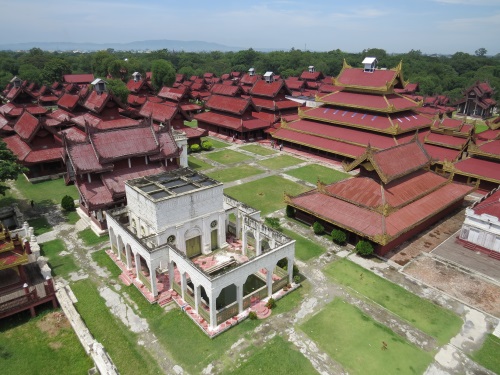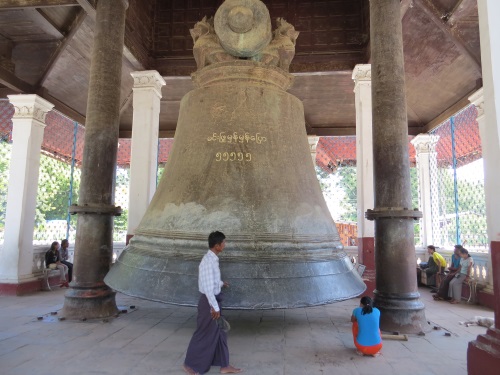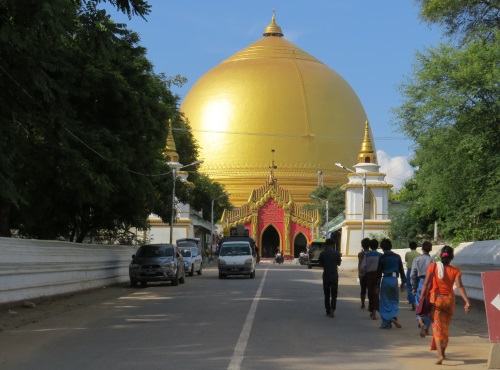The impressively titled TWHS
Ancient cities of Upper Myanmar comprises the former royal residences of Innwa, Amarapura, Sagaing, Mingun and Mandalay. They're located near Mandalay, Myanmar’s second city. Except for Mingun, the cities served also as state capitals for periods between the 14th and 19th century after the demise of
Bagan. The Burmese seem to be especially fond of switching
their capitals, using over 20 of them since the year 849. The current one (since 2005) is the greenfield site of
Naypyidaw.
 |
| Reconstruction of Mandalay Royal Palace |
I stayed in Mandalay for 4 nights, and - though admittedly I edged out a day for visiting the
Pyu City of Halin - that was even not enough to see these 'Ancient cities' properly. I spent one day cycling around Mandalay proper. It’s a bit of a mystery what would be included in a future nomination here. The Royal Palace is the major landmark of the city, but it is (a) a complete reconstruction and (b) used as a military base. The army probably is still convinced of the strategic value of the fortress walls and moat surrounding this zone. The outer wall has a huge sign saying ‘
The Tatmadaw Shall Never Betray the National Cause’, the only time I came across such a display during my two-week stay in Myanmar.
Although it’s a sensitive area, foreign visitors are welcome. I encountered a soldier with reasonable English posted at the only entrance gate, ordering tourists off their bikes in the most friendly way. The palace itself is worth a quick look from above from the viewing tower, but lacks any soul - so I cut my visit short and cycled onwards. Mandalay has numerous temples, monasteries and pagodas too of course. One of particular interest is the Kuthodaw pagoda – home to 729 little stupas together forming '
the world’s largest book'.
 |
| The Mingun Bell |
My first look outside of Myanmar’s bigger cities was via a boat trip to Mingun - the royal residence from 1810-1819. Already the spectacle at the ‘Mingun Jetty’ in Mandalay was worth the journey. The daily tourist ferry leaves at 9 a.m., and I arrived half an hour before. A number of less fortunate Mandalay citizens live close to the river, and have to wash themselves and their belongings in it. The harbour also provides small jobs for people in the loading and unloading of cargo from the ships. This involves getting the lower half of your body wet while wading through the dirty water,
balancing a load on your head. It was incredibly dirty and smelly, and I encountered a dead rat on the shore (not my first in Myanmar).
The 1 hour boat ride is a pleasure. Mingun is the result of the megalomania of the late 18th century King Bodawpaya. He wanted to create the world’s largest stupa, but stopped the works before they were done. The remaining brick structure can be seen from the river from afar. He did finish the world’s largest ringing bell. The people of Mingun now all seem to live off tourism, but I found it a pleasant place to look around for an hour or two. Supposedly an
entrance fee applies, but it was not actively collected when I visited. At 12.30 the ferry returns to Mandalay.
 |
| Kaunghmudaw Pagoda, Sagaing |
On my way out to Halin I had a quick look at Sagaing - capital of the eponymous kingdom of the 14th century and once again from 1760-1765 during the Konbaung Dynasty. The view from the bridge connecting Sagaing with Amarapura & Mandalay already is memorable: a hill dotted with innumerable golden stupas. A bit further along the road lie the more ancient temples and pagodas. These include the enormous
Kaunghmudaw Pagoda (nicknamed 'the big boob'), where the
controversial repainting from white to gold seems to have been completed.
I concur with what the other reviewers have said about the unlikeliness of this batch of Ancient Cities ever becoming a WHS in this form. But it's a very worthwhile region to spend a few days.